Userpilot for Retention Analytics: Features, Pricing, and Review
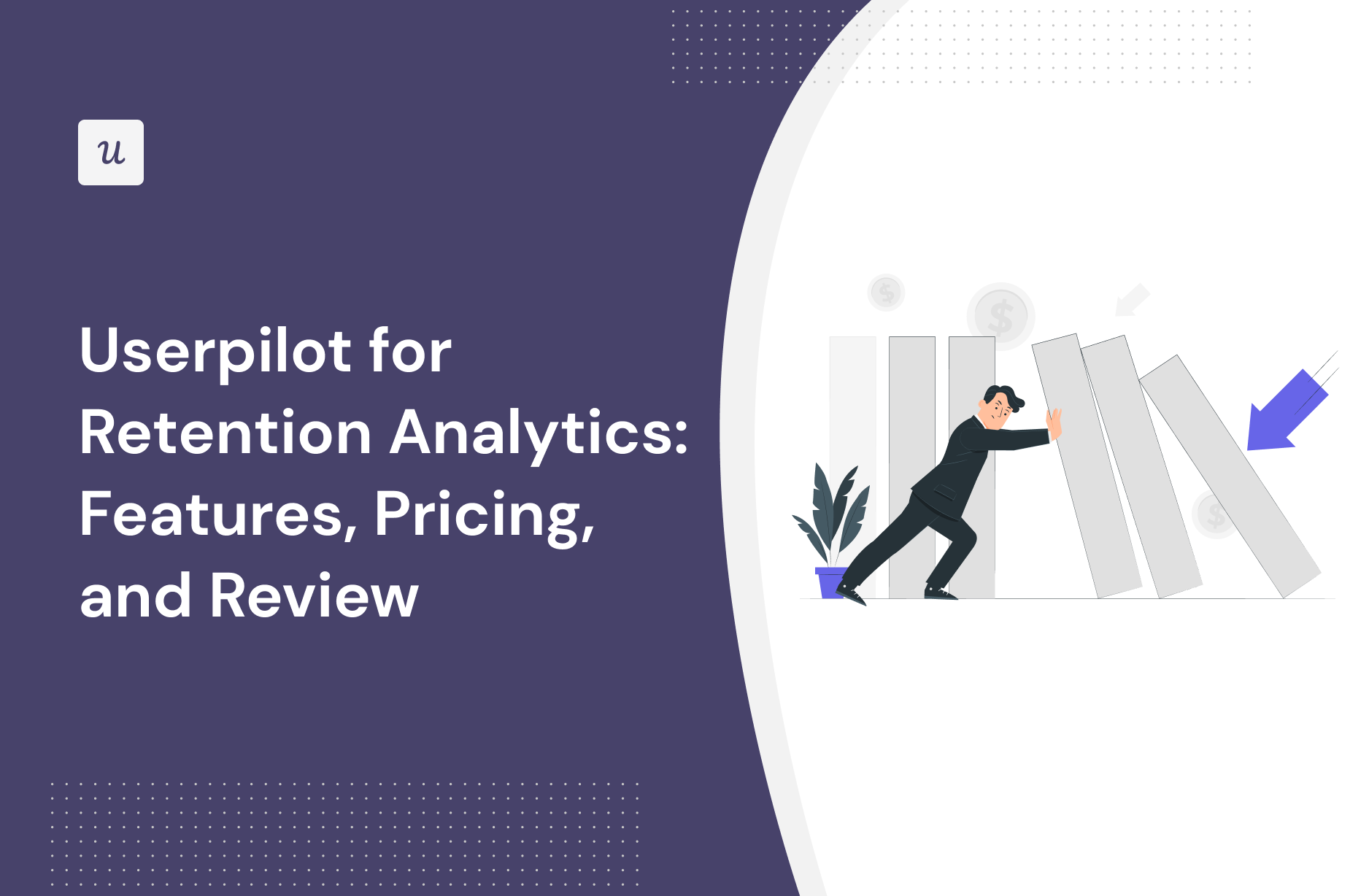
Looking for an effective retention analytics tool and wondering if Userpilot is the best option for your SaaS company?
With numerous Userpilot alternatives, it can be challenging to make a final decision.
In this article, we’ll delve into precisely that – helping you determine whether Userpilot is the ideal choice for your retention analytics needs. We’ll explore its features, pricing, and offer a comprehensive review to aid in your decision-making process.
Let’s get started!
TL;DR
- Here’s what to look for to maximize your company’s potential by leveraging advanced retention analytics tools:
-
- User segmentation: So you can slice and dice users based on behavior and demographics to develop laser-focused retention strategies.
- Churn prediction: To identify potential churn risks, aggressively re-engage customers, and keep them from leaving.
- Cohort analysis: So you can compare different user groups over time and figure out patterns that make them loyal or churn users.
- Engagement tracking: To track user behaviors and use trends to optimize engagement techniques.
- Retention funnel analysis: To visualize drop-offs, redesign the user path, and turbocharge retention for long-term success.
- Here are the Userpilot features you can use to analyze user retention:
-
- Funnels: Funnel reports show you the number of users who enter a funnel versus the percentage who complete it. Using Userpilot’s funnel reports to track activation points and adoption goals can help identify the stages where users drop off so you can patch these leaks.
- Trends: Trend reports let you see how specific product changes impact retention metrics and monitor changes in active user counts over certain time periods. You can also create custom metrics, track events, or use the breakdown tab to perform a correlative retention analysis.
- Cohort analysis: Analyze retention trends using cohort tables.
- All in all, Userpilot is a good choice for Retention analytics when it comes to core features for retention analytics such as funnels, paths, user segmentation analysis, and behavioral analytics.
- Ready to see Userpilot in action? Schedule a demo today to explore its powerful retention analytics capabilities firsthand.
What is Userpilot?
Userpilot is a product growth platform that drives user activation, feature adoption, and expansion revenue. It also helps product teams collect user feedback, streamline onboarding, and gather actionable insights from analytics.

With Userpilot, you’ll be able to track both product usage and user behavior to get a holistic view of how customers use your product — which will guide future development, improve the user experience, and inform your growth efforts.
Must have features of retention analytics tools
Here’s what to look for to maximize your company’s potential by leveraging advanced retention analytics tools:
- User segmentation: So you can slice and dice users based on behavior and demographics to develop laser-focused retention strategies.
- Churn prediction: To identify potential churn risks, aggressively re-engage customers, and keep them from leaving.
- Cohort analysis: So you can compare different user groups over time and figure out patterns that make them loyal or churn users.
- Engagement tracking: To track user behaviors and use trends to optimize engagement techniques.
- Retention funnel analysis: To visualize drop-offs, redesign the user path, and turbocharge retention for long-term success.
Userpilot features for retention analytics
Customer retention helps you reduce acquisition costs and drive expansion over time. Userpilot makes it easy to analyze retention using funnel reports, trend reports, and built-in goal tracking that can be filtered by segment/company/time period to provide actionable insights.
Here are the Userpilot features you can use to analyze user retention:
- Funnels: Funnel reports show you the number of users who enter a funnel versus the percentage who complete it. Using Userpilot’s funnel reports to track activation points and adoption goals can help identify the stages where users drop off so you can patch these leaks.
- Trends: Trend reports let you see how specific product changes impact retention metrics and monitor changes in active user counts over certain time periods. You can also create custom metrics, track events, or use the breakdown tab to perform a correlative retention analysis.
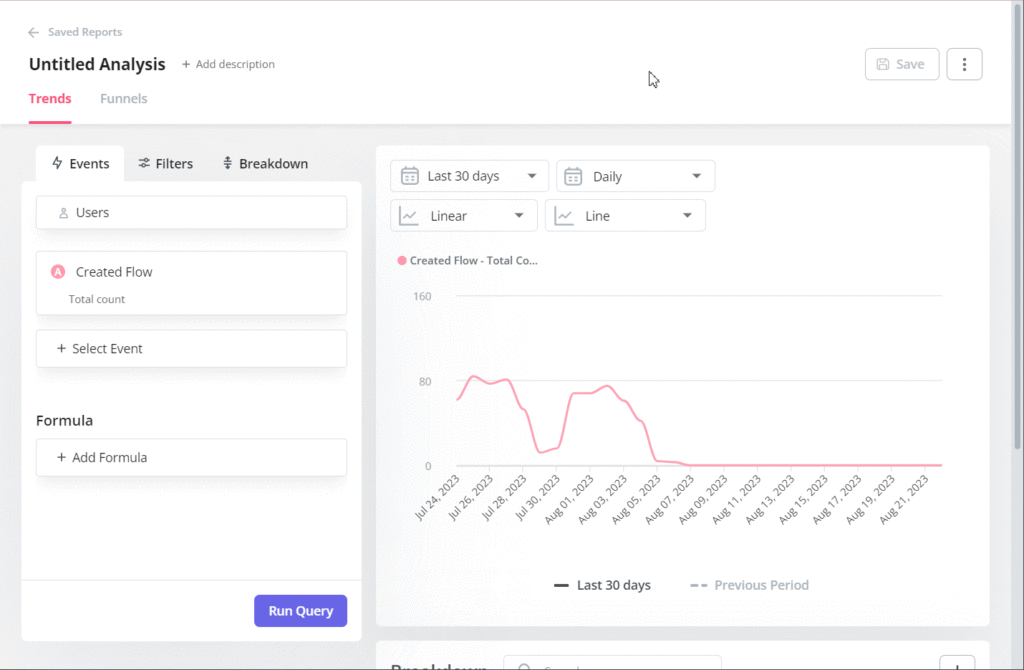
- Cohort analysis: Analyze retention trends using cohort tables.
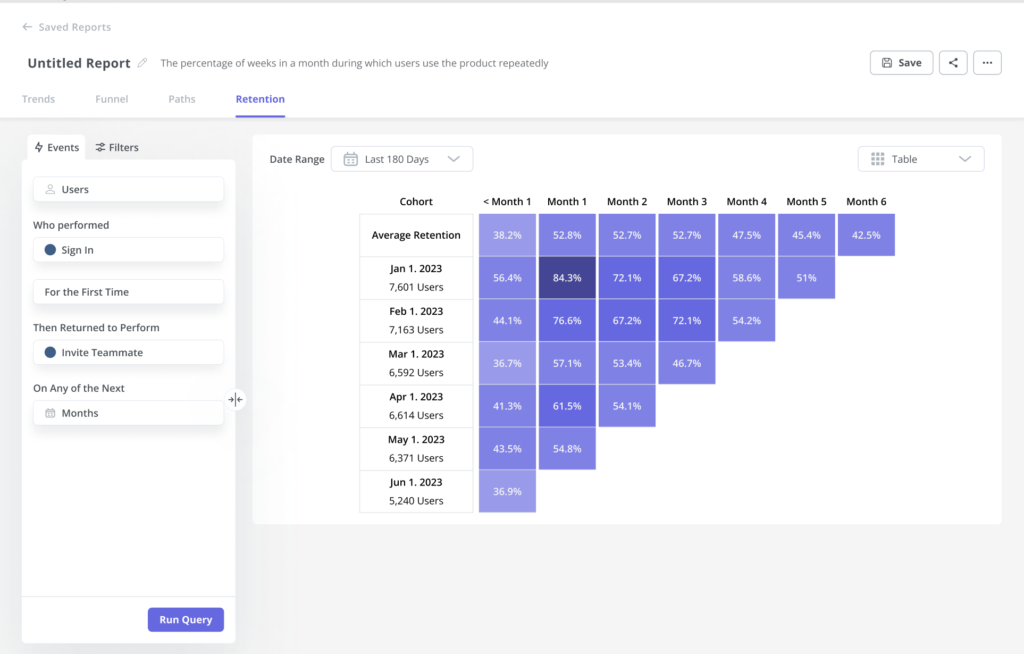
Userpilot’s funnels
Tracking user funnels is essential to getting a deeper understanding of the customer journey and reducing friction points. Userpilot helps you track user funnels by creating funnel reports, reviewing saved reports in bulk, and seeing key metrics like the average time it takes to complete a funnel.
Here’s how you can use Userpilot to generate funnel charts:
- Funnels: Userpilot’s funnel reports can show you the percentage of users that progress from one stage to another. Stages could consist of pages, actions, or other activation points. You can also set a specific order that these steps need to be completed or adjust the time period.

- Reports: The saved reports area of your Userpilot account lets you view, edit, duplicate, delete, or export (as a CSV file) all the analytics reports that you (or your teammates) have generated. You can also filter results by the teammate who created the report or the type of report.
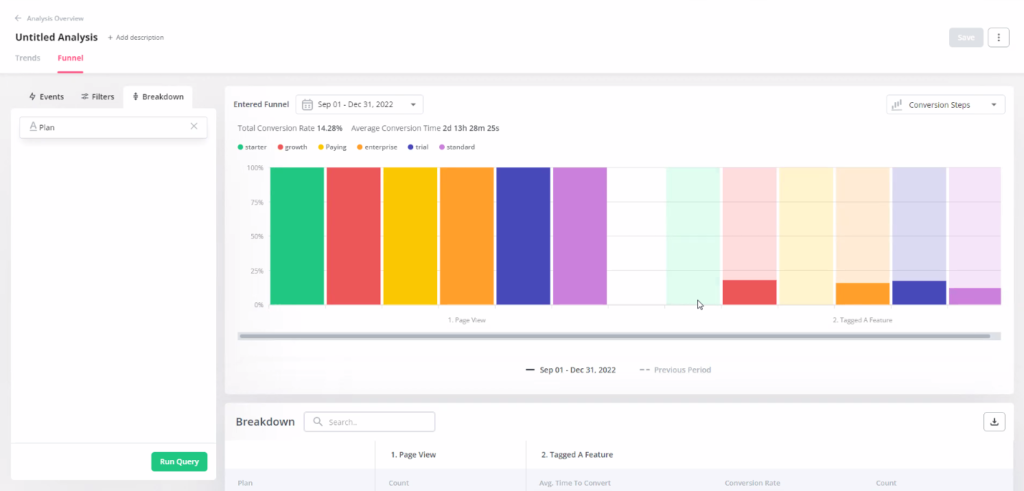
- Duration: The granular funnel analytics can offer more insights into each stage of a particular user funnel, such as how long it took the majority of your users to complete it from start to finish. You can filter by time period and set minimum/maximum parameters to remove outliers.

Userpilot’s paths
Path reports are essential for understanding user flows and journeys, offering invaluable insights into their interactions with our platform or application.
Within the Paths chart(s) visualization in Userpilot, you can:
- See the different flows/links users take from one step/event to another.
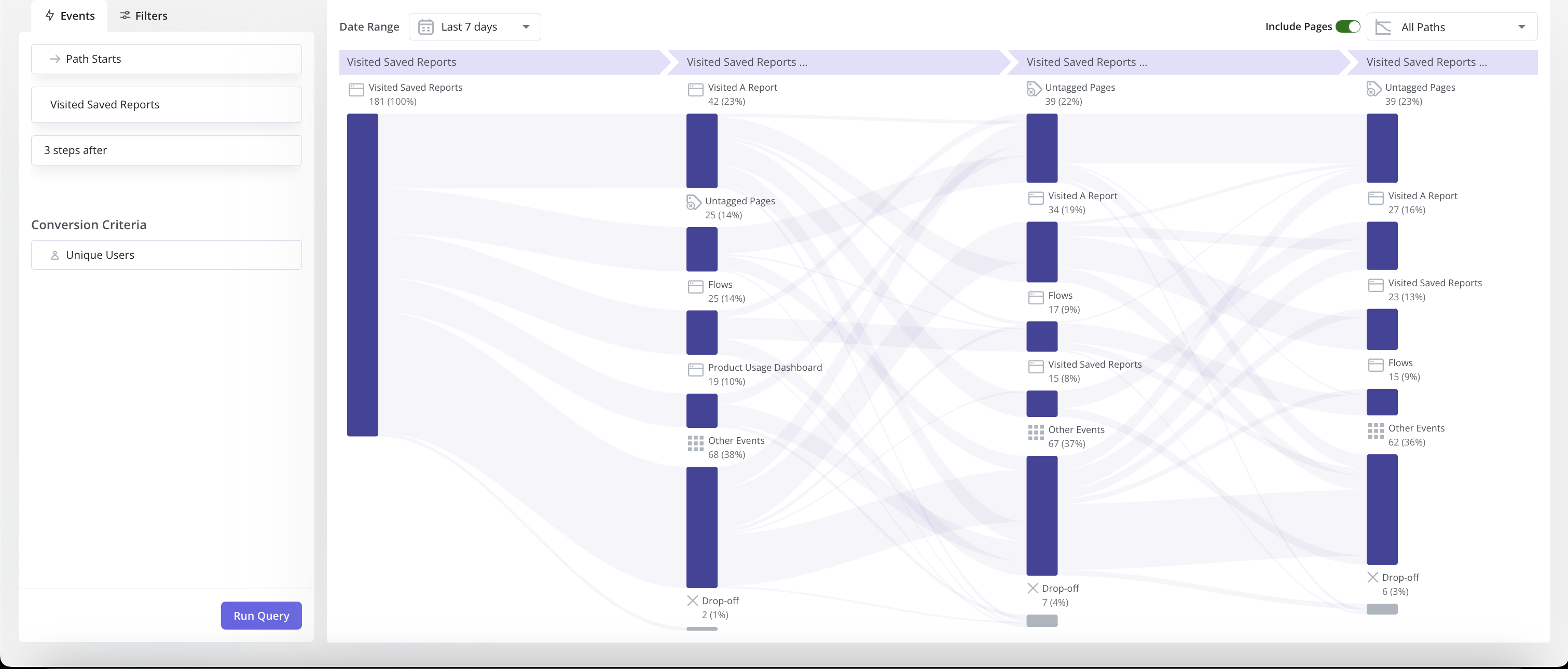
- Choose how many steps after or before the starting/ending event you want to report Users’ flows for.
- Choose whether you want to include Pages (i.e. Both User-Tagged and Untagged) in the visualization.
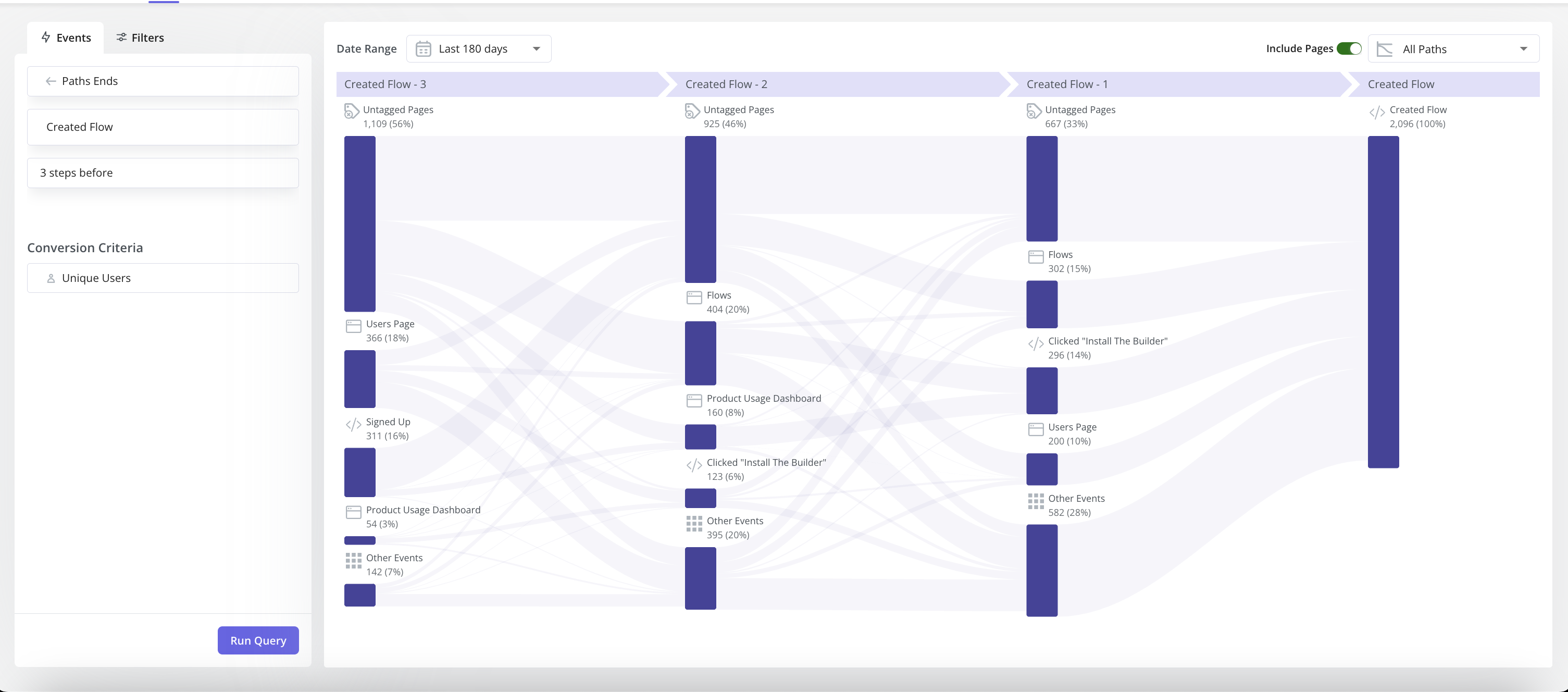
- Change the period of the analysis.
- Change the way you want to view the analysis: All Paths vs. Top Path (i.e. most common).

- Narrow down the targeted end-users by applying global or inline (event-specific) filters.
- View a breakdown of the end-users (or their associated companies) upon clicking on a specific node/step in the visualization chart.
You also have automatic path analysis in Userpilot’s core feature engagement analytics dashboards without having to set up anything. This will give you an overview of user navigation and engagement with your product so you have insights to work on improving their experience. 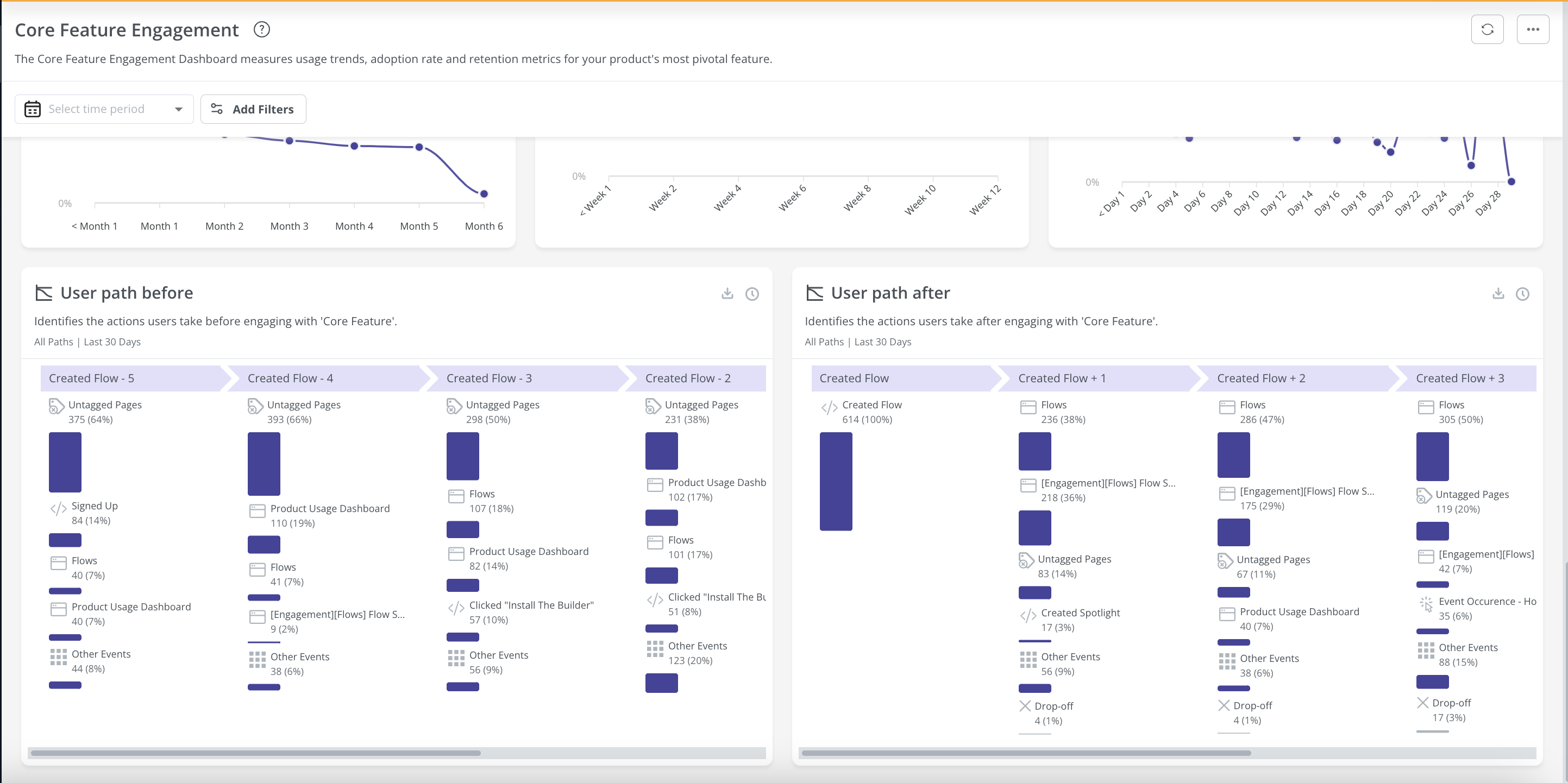
Userpilot’s user segmentation analysis
User segmentation is a key part of building a contextual onboarding experience for new customers. Userpilot lets you segment your customers when they meet specific conditions, filter through analytics using user attributes, and trigger flows for users in different segments.
Here are some of Userpilot’s customer segmentation capabilities:
- Conditional Segments: Userpilot lets you build segments for users who match conditions on what device/browser/OS they’re using, which country they live in, what their NPS score is, and any custom events they’ve performed. You can then use these segments as filters/triggers.
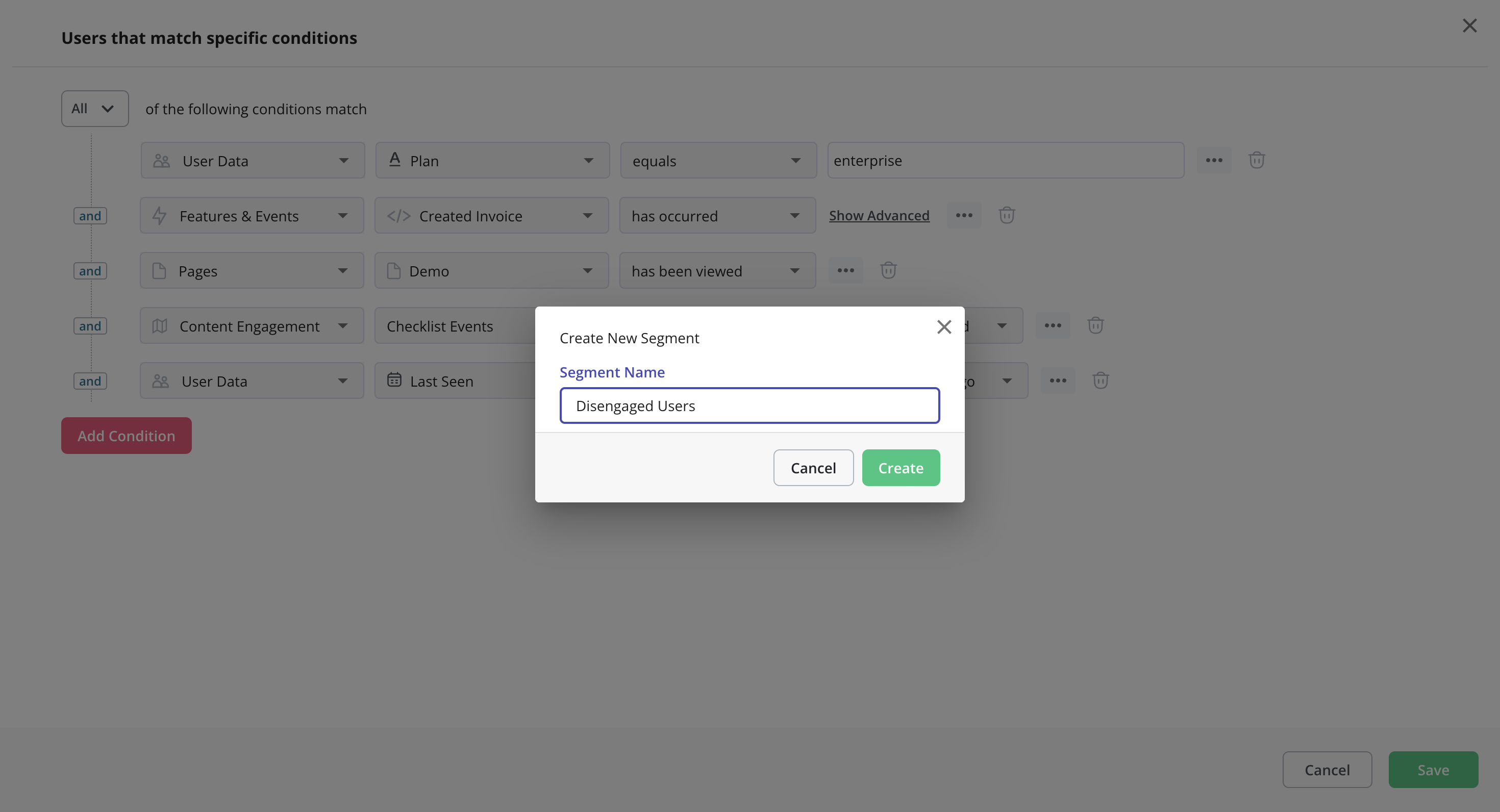
- Analytics Filters: The product analytics and user insights dashboards on Userpilot can be set to only show data from certain user segments or companies. This makes it possible to identify actionable insights from specific user cohorts and benchmark performance between segments.
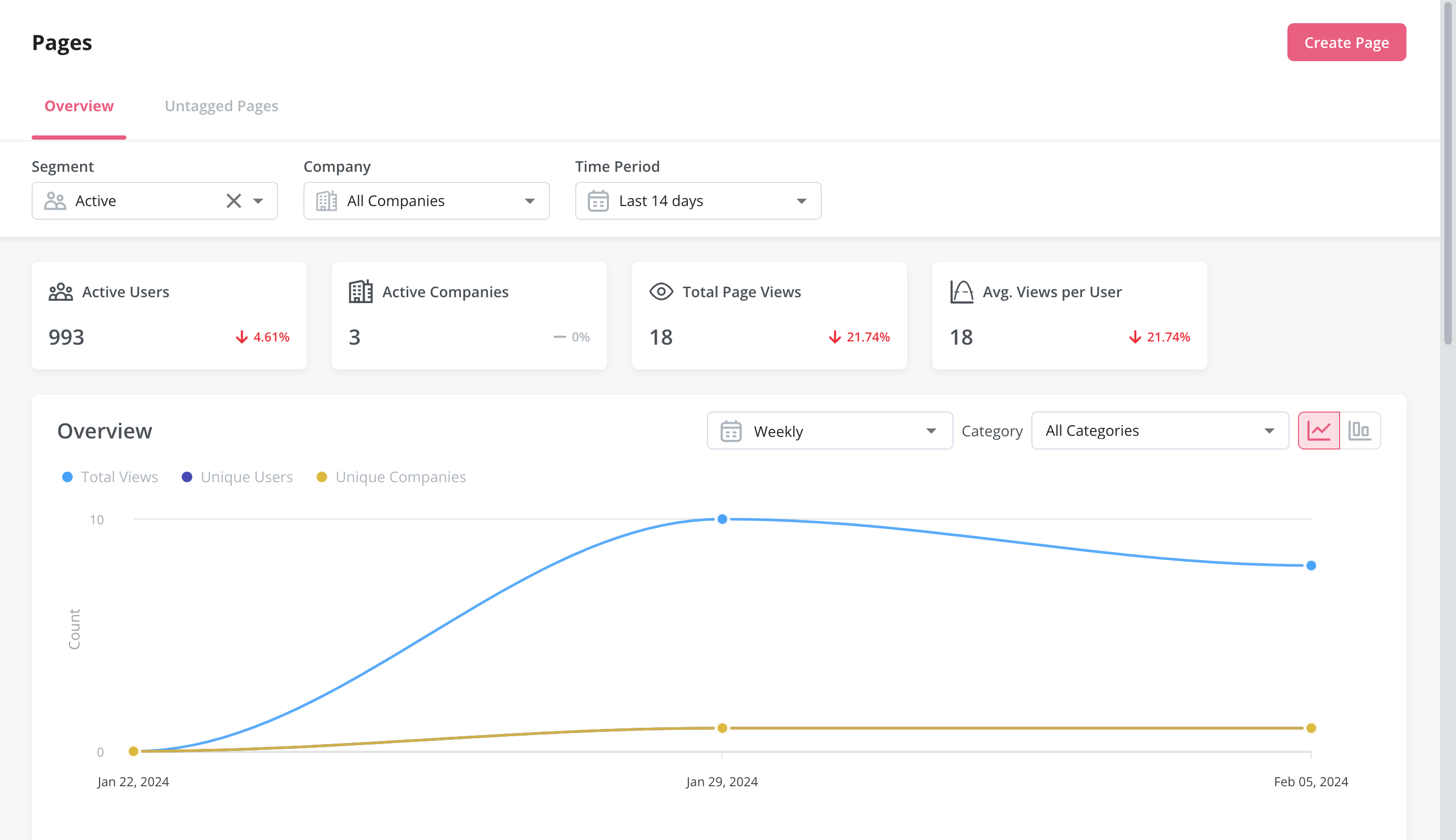
- Flow Triggers: Userpilot audience settings make it possible to target in-app flows to certain user segments or only show flows to users who meet specific conditions. You could also add event-based or page-specific triggers to show relevant flows with contextual timing.
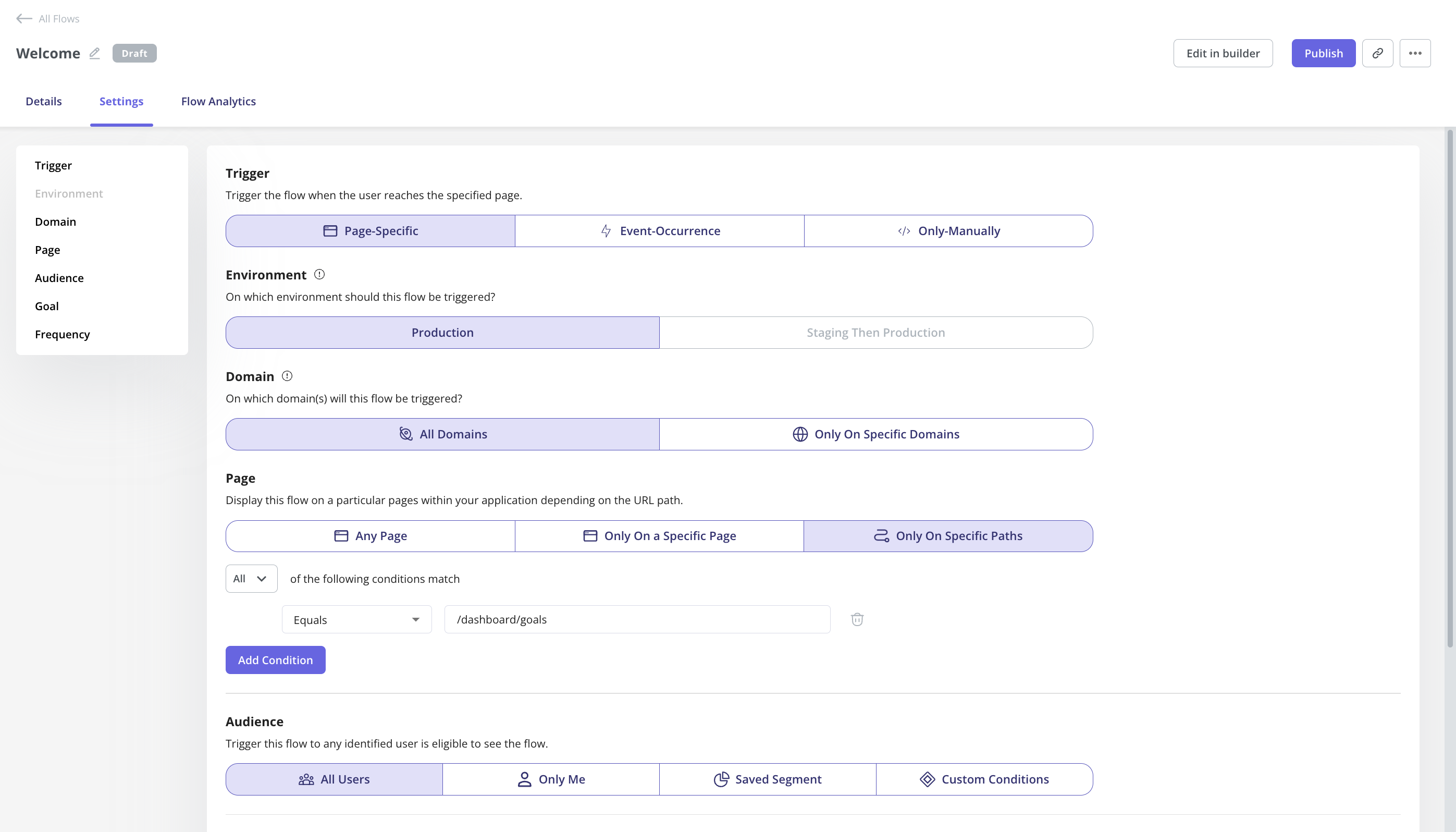
Userpilot’s behavioral analytics
Behavioral analytics make it possible to monitor user activity, group data into cohorts, and extract relevant metrics/insights. Userpilot lets you tag features to see how users interact with them, compare goals by cohort, and create trend reports that track behavioral patterns over time.
Here are some Userpilot features you can use for user behavior tracking:
- No-Code Feature Tagging: Userpilot’s click-to-track feature tagger lets you mark features, buttons, and elements with the Chrome extension. You’ll be able to track user interactions such as clicks, hovers, or inputs to get an accurate behavioral view for specific features.
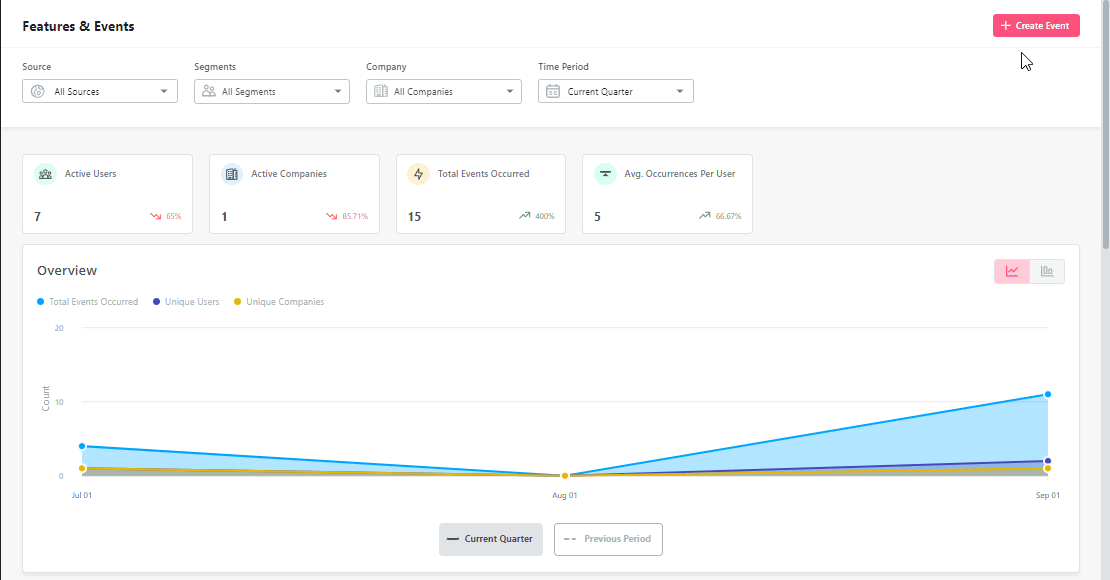
- Funnel Reports: Funnel reports show you the total number of users that enter a funnel and the percentage of users that complete each step. This can help you track behavioral paths and see which stages most users get stuck on.

- Trends Reports: Generating trends reports will help you visualize the occurrence of key events over time and break down these analytics by device, browser, operating system, country, signup date, or even individual user IDs and email addresses to see granular behavioral analytics.
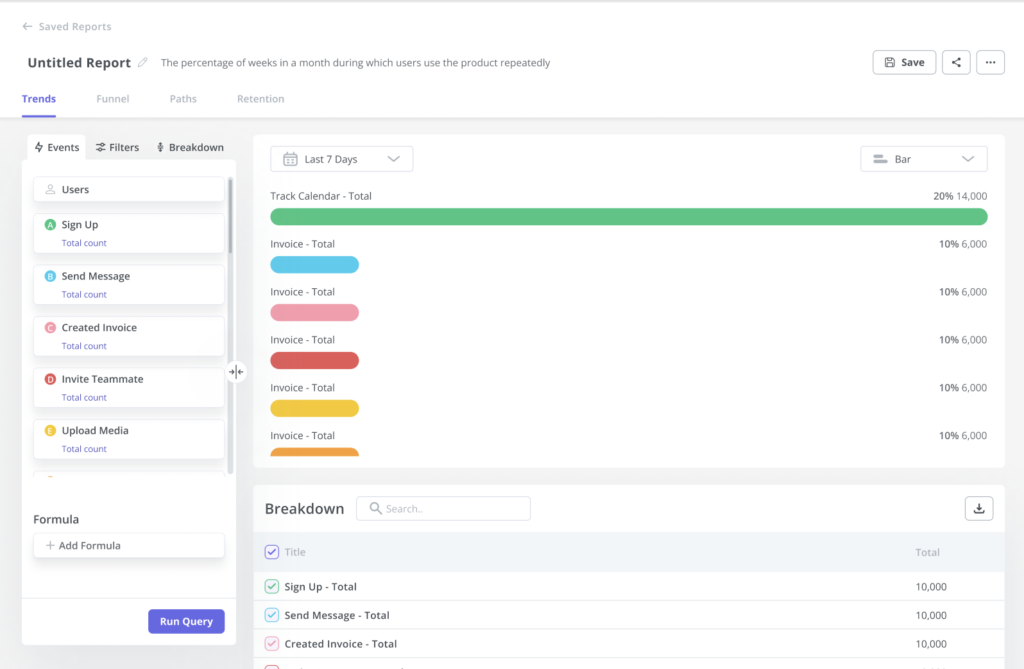
- Path Reports: Path analysis is useful for understanding common user behavior patterns, gauging user interactions with UI, monitoring if users follow recommended workflows, and identifying points of drop-offs and areas for improvement. With collected events, you can easily set up Path analysis in Userpilot without coding.

What are the pros and cons of Userpilot?
Userpilot’s pros
As a full-suite digital adoption platform, Userpilot has all the features you need to onboard users, track analytics, and gather feedback from customers without writing a single line of code. Here are a few pros of using Userpilot as your product growth solution:
- No-code builder: Userpilot’s Chrome extension lets you build flows, add UI elements, and tag features without writing a single line of code.
- UI patterns: There are plenty of UI patterns to choose from when using Userpilot, such as hotspots, tooltips, banners, slideouts, modals, and more!
- Startup-friendly: Userpilot’s entry-level plan gives you access to all available UI patterns so you can hit the ground running.
- Walkthroughs and flows: Build engaging interactive walkthroughs and personalized onboarding flows that target specific segments of your user base.
- Self-service support: Build an in-app resource center to help users solve problems, customize its appearance to align it with your brand, and insert various types of content (videos, flows, or chatbots) to keep your customers satisfied.
- A/B testing: Userpilot’s built-in A/B testing capabilities will help you split-test flows, iterate on the best-performing variants, and continually optimize based on user behavior.
- Feedback collection: Userpilot has built-in NPS surveys with its own unified analytics dashboard and response tagging to help you retarget users. There are other survey types to choose from and you can even create your own custom survey.
- Survey templates: There are 14 survey templates to choose from so you can gather feedback on specific features or run customer satisfaction benchmarking surveys like CSAT and CES.
- Advanced analytics: Userpilot lets you analyze product usage data, monitor engagement on all in-app flows, and use the data to create user segments that are based on behaviors instead of demographics.
- Event tracking: Userpilot’s no-code event tracking lets you tag UI interactions (hovers, clicks, or form fills) and group them into a custom event that reflects feature usage.
- Third-party integrations: Userpilot has built-in integrations with tools like Amplitude, Mixpanel, Kissmetrics, Segment, Heap, HubSpot, Intercom, Google Analytics, and Google Tag Manager so you can share data between all the solutions in your tech stack.
Userpilot’s cons
Of course, no tool is perfect and there are a few cons to consider before choosing Userpilot as your user onboarding or product growth solution:
- Employee onboarding: Currently, Userpilot only supports in-app customer onboarding.
- Mobile apps: Userpilot doesn’t have any mobile compatibility which could make it difficult for developers with cross-platform applications to create a consistent user experience for both versions of their product.
- Freemium plan: There’s no freemium Userpilot plan so those bootstrapping their startup and need sub-$100 solutions should consider more affordable onboarding platforms like UserGuiding or Product Fruits.
What do users say about Userpilot?
Most users laud Userpilot for its versatile feature set, ease of use, and responsive support team:
I recently had the pleasure of using Userpilot, and I must say it exceeded all my expectations. As a product manager, I’m always on the lookout for tools that can enhance user onboarding and improve overall user experience. Userpilot not only delivered on these fronts but also went above and beyond with its impressive new features, unparalleled ease of use, and truly exceptional customer support.
What truly sets Userpilot apart is its outstanding customer support. Throughout my journey with Userpilot, the support team has been responsive, knowledgeable, and genuinely dedicated to helping me succeed. Whenever I had a question or encountered an issue, their support team was always there to assist promptly, going above and beyond to ensure my concerns were addressed effectively.

Source: G2.
Of course, other users are also kind enough to share constructive criticism regarding specific features like event tracking filters:
“The filtration while analyzing specific events is a little confusing. Understanding of custom properties and data management configuration could have been more organised.”

Source: G2.
Userpilot’s pricing
Userpilot’s transparent pricing ranges from $249/month on the entry-level end to an Enterprise tier for larger companies.
Furthermore, Userpilot’s entry-level plan includes access to all UI patterns and should include everything that most mid-market SaaS businesses need to get started.

Userpilot has three paid plans to choose from:
- Starter: The entry-level Starter plan starts at $249/month and includes features like segmentation, product analytics, reporting, user engagement, user feedback, and customization.
- Growth: The Growth plan starts at $499/month and includes features like resource centers, advanced event-based triggers, unlimited feature tagging, AI-powered content localization, EU hosting options, and a dedicated customer success manager.
- Enterprise: The Enterprise plan uses custom pricing and includes all the features from Starter + Growth plus custom roles/permissions, access to premium integrations, priority support, custom contract, SLA, SAML SSO, activity logs, security audit and compliance (SOC 2/GDPR).
Conclusion
There you have it.
It should be easier now to make an informed decision whether Userpilot is your go-to option for retention analytics. Ultimately, the best choice will depend on your product and current needs.
Book a Userpilot demo today to experience firsthand how it can enhance your user experience and drive product growth!


